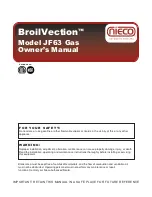
Page 16
LAARS HEATING SYSTEMS
1.
Remove the louvered plate from the left side of
the boiler.
2.
Remove the adapter plate from the shipping
container.
3.
Install the blower motor housing collar in gasket.
4.
Slip one end of the inlet pipe over the collar on
the adapter plate.
5.
Slide the inlet pipe and adapter plate into the
boiler opening until the pipe is aligned with the
blower motor.
6.
Slip the end of the inlet pipe over the blower
motor housing collar.
7.
Secure the adapter plate to the side of the boiler
with the 4 screws.
2M-4. Combustion Air Piping
Run piping of the appropriate size between the
air intake terminal and the boiler (see Table 7). Table
9 lists the materials for piping the boiler.
Term
Description
Pipe
Single-wall galvanized steel pipe,
24 gauge minimum.
Joint Sealing
Permanent duct tape or aluminum
tape
Insulation
Not required, but recommend R5
insulation for cold installations
(consult American Society of
Heating, Refrigerating, and
Air Condditioning Engineers
(ASHRAE) handbook
Table 9. Required Combustion Air Piping Material.
2N. Electrical Wiring
WARNING
Electrically ground the heater in accordance
with the latest edition of ANSI/NFPA 70. In
Canada, use CSA C22.1. Do not rely on the
gas or water piping to ground the metal parts
of the heater. Often, plastic pipe or dielectric
unions isolate the boiler electrically. Service
and maintenance personnel who work on or
around the boiler may be standing on wet
floors and could be electrocuted by an
ungrounded boiler.
1.
Check boiler wiring and pump for correct
voltage, frequency, and phase.
2.
Wire the boiler and pump exactly as shown in
the wiring diagram supplied with the boiler (see
Figure 12).
3.
Electrically interlock the pump and boiler so the
boiler cannot come on unless the pump is
running.
4.
Connect all field-installed devices (relays,
timers, temperature devices, etc.) to the boiler
wiring at points labeled “Field Interlock” (see
Figure 12).
SECTION 3.
Operation
WARNING
Do not use this appliance if any part has been
under water. Immediately call a qualified
service technician to replace the appliance.
3A. Start Up Requirements
Lighting: Safe lighting and other performance
criteria were met with the gas manifold and control
assembly provided on the boiler when it underwent
tests specified in ANSI Z21.13 Standard.
Before placing the boiler in operation, check the
automatic safety shutoff devices. Once the boiler is
connected to the gas piping and after all of the
requirements in Section 2 have been met, follow this
procedure:
1.
Before beginning the tests, make sure the main
manual gas valve, and any other boiler firing
valves, are in the OFF position.
NOTE: The gas valve is turned off as follows:
•
Size 775/1000
Valve is OFF when handle is at
right angle to gas pipe.
•
Sizes 520/625
Turn clockwise to OFF and
•
Sizes 320/400
Press in gas control knob
slightly and turn clockwise to
OFF. Knob cannot be turned
unless it is pushed in slightly.
Do not force it.
2.
Make sure the power switch on the boiler is in
the ON position. Reset all safety devices (high
limit, pressure switch, Low-Water-Cutoff, etc.).
3.
Normal Operating Sequence
When the circulation pump is running, the boiler
will turn itself on and off in response to the
water temperature. When the water cools below
the set temperature, the following sequence
occurs:
a.
The aquastat powers the ignition control.
b.
The ignition control turns on the
combustion fan. After about a 15 second
















































